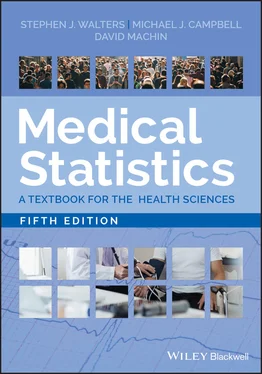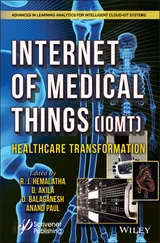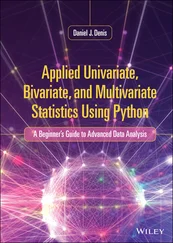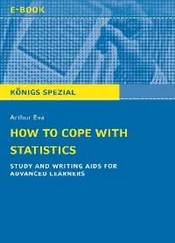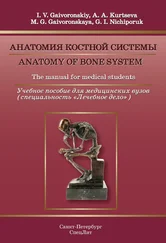Thus in the corn plaster trial, the odds ratio for the corn not healing or resolving at three months in the plaster group compared to the scalpel group is (20 × 63)/(32 × 74) = 0.532; which is the same as the reciprocal or inverse of the odds ratio for the corn resolving at three months in the plaster group compared to the scalpel group or 1/1.879 = 0.53. In contrast the relative risk ratio for the corn not healing or resolving at three months in the plaster group compared to the scalpel group (1 − 0.337)/(1 − 213) = 0.842, which is not the same as the inverse of the relative risk for the corn resolving at three months in the plaster compared to the scalpel group, which is 1/1.583 = 0.632. This symmetry of interpretation of the OR is one of the reasons for its continued use.
The Odd Ratios are Symmetrical but the Relative Risk Is Not
Consider the data in the 2 × 2 contingency table of Table 3.7where the relative risk of being alive in the exposed compared to the not exposed group is relative risk (alive) = 0.96 /0 99 = 0.97; the reciprocal is 1/relative risk (alive) = 1/ 0.97 = 1.03. The relative risk (dead) = 0.04/0.01 = 4. Thus, note that the relative risk (dead) is not equal to 1 / relative risk (alive).
Table 3.7 Example of a two by two contingency table with a binary outcome (alive or dead) and two groups of subjects (exposed or not exposed).
| Outcome |
Test treatment exposed |
Control treatment not exposed |
| Alive |
0.96 |
0.99 |
| Dead |
0.04 |
0.01 |
| Total |
1.00 |
1.00 |
The odds ratio (alive) = (0.96/0.04) / (0.99/0.01) = 0.24; the reciprocal is: 1/odds ratio (alive) = 1/ 0.24 = 4.13. The odds ratio (dead) = (0.04/0.96)/(0.01/0.99) = 4.13; and hence the odds ratio (dead) is equal to 1/odds ratio (alive).
To understand risks that are smaller than 1% (or 1 in 100) you may find it helpful to compare these risks to other risks in life. Some people use words like ‘high’ or ‘low’ to talk about risk. So Calman (1996), an expert in risk communication, has produced a ‘risk classification’ scale that looks at particular risks and suggests words that the public and health care professionals can use to describe them. An outline of the scale is given in Table 3.8.
Table 3.8 Risk of an individual dying (D) in one year or developing an adverse response (A)
( Source: Calman 1996).
| Term used |
Risk range |
Example |
Risk estimate |
| High |
>1:100 |
(A) Transmission to susceptible household contacts of measles and chickenpox (A) Transmission of HIV from mother to child (Europe) |
1:1–1:2 1:6 |
| Moderate |
1:100–1:1000 |
(D) Smoking 10 cigarettes per day (D) All natural causes, age 40 |
1:200 1:850 |
| Low |
1:1000–1:10 000 |
(D) All kinds of violence (D) Influenza (D) Accident on road |
1: 300 1:5000 1:8000 |
| Very low |
1:10 000–1:100 000 |
(D) Leukaemia (D) Playing soccer (D) Accident at work |
1:12 000 1:25 000 1:43 000 |
| Minimal |
1:100 000–1:1 000 000 |
(D) Accident on railway |
1:500 000 |
| Negligible |
<1:1 000 000 |
(D) Hit by lightning (D) Release of radiation by nuclear power station |
1:10 000 000 1:10 000 000 |
Table 3.9 Results of randomised controlled trial in primary care in patients with venous leg ulcers to compare a new specially impregnated bandage, called ‘Band aid’, with usual care.
| Leg ulcer completely healed |
Group |
| Band‐aid intervention |
Usual care control |
| Yes, healed |
147 |
123 |
| No, not healed |
63 |
82 |
| Total |
210 |
205 |
From the data in Table 3.9:
3.2 Points When Reading the Literature
1 Is the number of subjects involved clearly stated in the table?
2 Are the row and columns in the table clearly labelled?
3 Do the titles adequately describe the contents of the table?In tables:
4 If percentages are shown, is it clear whether they add across rows or down columns? For example in Table 3.4it is clear the percentages total down the columns, not across the rows.
5 Percentages should not have decimal places if the number of subjects in total is less than 100.Summary statistics:
6 If a relative risk is quoted, what is the ARD? Is this a very small number? Beware of reports that only quote relative risks and give no hint of the absolute risk!
7 If an odds ratio is quoted, is it a reasonable approximation to the relative risk? (Ask what the size of the risk in the two groups are).
Table 3.9shows the results of randomised controlled trial in primary care in patients with venous leg ulcers to compare a new specially impregnated bandage, called ‘Band aid’, with usual care. Usual care will be treatment by district nurses with standard bandages and wound dressings. The primary outcome for the study will be whether or not the index or reference leg ulcer has completely healed at a 12‐month post‐randomisation.
1 3.1 What proportion of patients in the Band‐aid group had a completely healed leg ulcer at 12 months?0.300.400.600.650.70
2 3.2 What proportion of patients had a completely healed leg ulcer at 12 months in the control group?0.300.400.600.650.70
3 3.3 What is the difference in response (leg ulcer healing rates at 12 months) between the Band‐aid and control groups?−0.10−0.050.000.050.10
4 3.4 Calculate the number of people needed to be treated with Band‐aid dressing in order for an additional person to have a completely healed leg ulcer at 12 months compared to people usual care?6 78810
5 3.5 What is the relative risk for the leg ulcer healing at 12 months in the Band‐aid group compared to the control group?0.640.861.171.562.33
6 3.6 What is the relative risk for the leg ulcer healing at 12 months in the control group compared to the Band‐aid group?0.640.861.171.562.33
7 3.7 What are the odds for the leg ulcer healing at 12 months in the Band‐aid group?0.640.861.501.562.33
8 3.8 What are the odds for the leg ulcer healing at 12 months in the control group?0.640.861.501.562.33
9 3.9 Calculate the odds ratio for the leg ulcer healing at 12 months in the Band‐aid group compared to the control group?0.640.861.171.562.33
10 3.10 Calculate the odds ratio for the leg ulcer healing at 12 months in the control group compared to the band‐aid group?0.640.861.171.562.33
4 Probability and Distributions
1 4.1 Types of Probability
2 4.2 The Binomial Distribution
3 4.3 The Poisson Distribution
4 4.4 Probability for Continuous Outcomes
5 4.5 The Normal Distribution
6 4.6 Reference Ranges
7 4.7 Other Distributions
8 4.8 Points When Reading the Literature
9 4.9 Technical Section
10 4.10 Exercises
Probability is defined in terms of either the long‐term frequency of events, as model based or as a subjective measure of the certainty of an event happening. Examples of each type are given. The concepts of independent events and mutually exclusive events are discussed. Several theoretical statistical distributions, such as the Binomial, Poisson and Normal are described. The properties of the Normal distribution and its importance are stressed and its use in calculating reference intervals is also discussed.
Читать дальше
